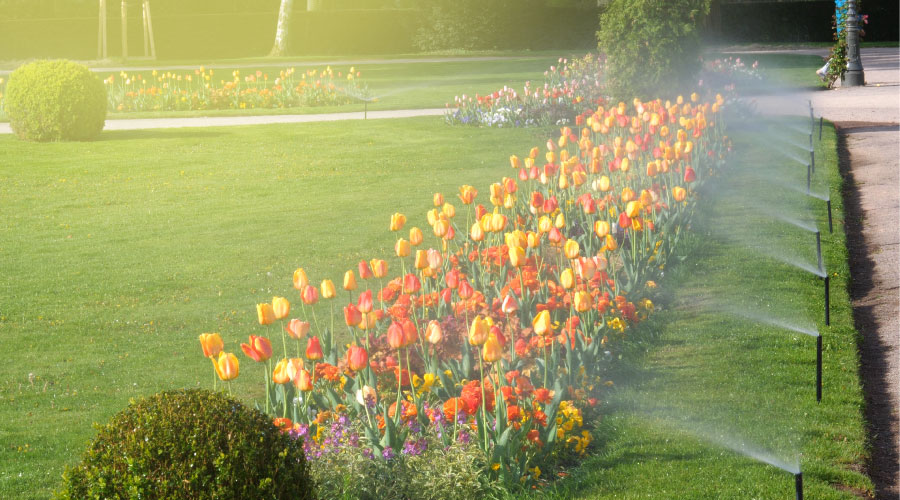Water-saving Benefits of Smart Irrigation Systems
Leak detection and weather adjustments help maximize efficiency.
By Marty Farmer, Contributing Writer
From government parks to college campuses to sports stadiums, facilities need an irrigation system to keep grounds looking their best during the warm spring and summer seasons.
Some of the most commonly used irrigation systems are drip, sprinkler, center pivot, furrow and terraced. These systems are all viable options. However, the relatively new method of smart irrigation uses weather data or soil moisture data to determine the irrigation needs of a landscape. It's been labelled by many within the industry as a game changer.
So, what exactly is smart irrigation?
“Smart irrigation means that an irrigation controller or system has a computer that can adjust irrigation run times or events based on weather conditions (evapotranspiration-based or ET) or soil moisture levels,” says Brandon Haley, senior project manager for grounds and sustainability at SSC Services for Education. “Typically, they will also have the ability to measure flow rates and shut the system down if there is a break in either the mainline or a particular zone and notify a set group of users. This leads to a more efficient irrigation system that reduces water consumption.”
Smart irrigation systems are much more effective and efficient than traditional irrigation controllers that operate on a preset programmed schedule and timers.
A connection to the internet or a sensor that feeds information to a computer is needed to utilize smart irrigation. Then, the system is connected to a local weather station to collect the data. Newer systems are cloud-based, giving the end user remote control of the system from anywhere.
Each brand has a different proprietary algorithm that combines weather information with information on plant type, soils, slope, etc. to set a run time that will deliver the amount of water needed for plant growth. Most systems don’t work perfectly out of the box, but all can be adjusted over time to deliver pinpoint amounts of water.
Benefits
If a smart irrigation system is properly dialed in and run with tight parameters, waste can be nearly eliminated by reduced usage and early leak detection, says Haley. The smart irrigation system sends its users a real-time alert that a leak has been detected and the system has been shut down.
In less ideal scenarios, thousands of gallons can be lost due to problematic leaks that are not detected when irrigation runs at night at unattended sites. Consequently, leaks can go unnoticed for weeks or months.
“Water conservation is the main benefit [of smart irrigation],” Haley says. “The other benefit is remote access. Newer systems work off of either Wi-Fi or cell service and can be controlled from anywhere. This allows for easier service, faster adjustments and the confidence of knowing what your system is doing in real-time.”
Smart irrigation controllers import weather data to the controller and adjust its settings, much like a thermostat adjusts an air conditioning system. Instead of having a basic, timer-based program that will operate regardless of what the weather is doing, smart systems adjust the times and days they provide water according to the demand or need for irrigation, based on weather.
“The system runs irrigation at maximum efficiency,” says Amy Fouty, athletic field consultant with The Motz Group. “Water is supplied to the grass/landscaping area based on the data rather than just programmed time to maintain plant health and vigor. Software calculates the need based on weather data provided (temperature, soil conditions, evapotranspiration, [and] weather conditions) and then operates according to the programmed schedule.”
Facilities that do not have a turf or landscape technician on staff to manage daily changes manually benefit most from smart irrigation. However, the system can be beneficial for virtually any kind of site.
“Any site that has irrigation should seriously consider a smart irrigation system,” Haley says. “The system will limit the site’s water usage, reduce the amount of times they adjust the system, control the system remotely or reduce their waste due to leaks.”
While the algorithms don’t always work as well in certain parts of the country, leak detection alone makes investing in a smart irrigation system a wise decision for any grounds manager.
“In our experience, the return on investment of a smart controller is usually within three years,” Haley says. “That’s well inside the expected life of the irrigation system. And with the explosion of AI technology, I expect that these products will rapidly get better and will continue to shrink the ROI period.”
Potential challenges
Although using a smart irrigation system provides many benefits, there are potentially a few obstacles. One concern is the cost of purchasing, installing and maintaining the equipment. Other problems include human error when setting up the system and the increased maintenance of channels and equipment to ensure it works correctly.
Several other factors must be considered to ensure the correct installation of a smart irrigation system. These factors include the placement of landscape beds on separate zones from grass; sprinkler placement, pressure and nozzle selection; condition of the components; soil type, condition and slope; and plant requirements.
Regardless of geographic location or venue, water costs are rising faster than other utility costs. Using a smart irrigation system helps facilities get ahead of the water cost curve and helps the environment via water conservation.
Marty Farmer is a freelance writer with Advantage Informatics.
Related Topics:












